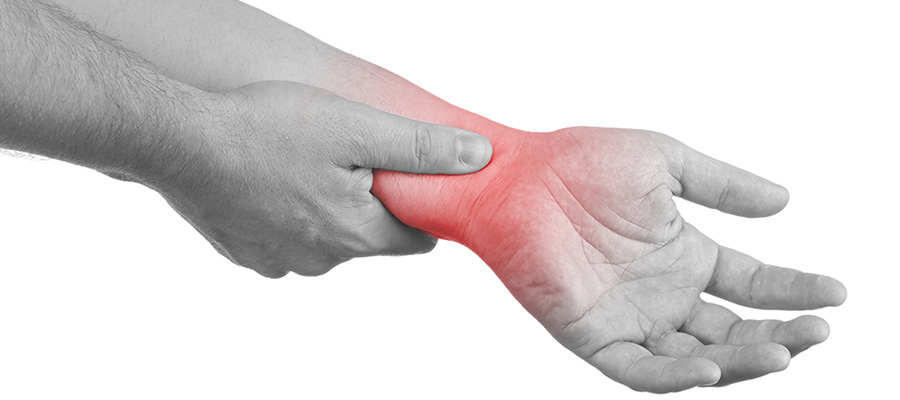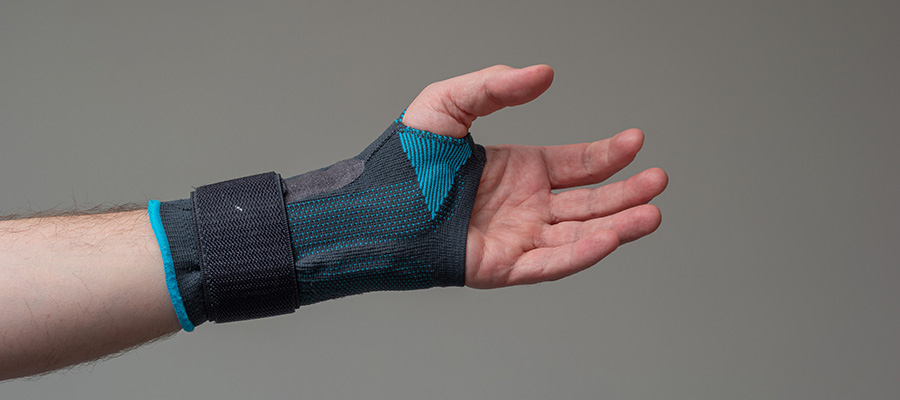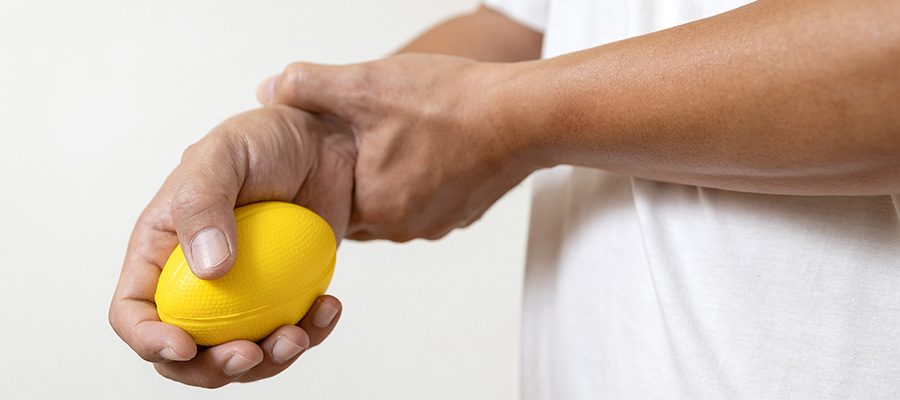
TFCC Injury Overview
This wrist injury affects baseball players, gymnasts, and racquet-sport players. High-impact hits and landing hard and fast on the hands can cause injury to the ulnar side or little finger side of the wrist.
TFCC Injury is Treatable with Favourable Outcomes
Mild injuries and TFCC injuries in their early stages may appear similar to a wrist sprain. Often, mild TFCC injuries may be treated with immobilization via splinting with favourable outcomes. Due to the complex nature of the soft tissues of the wrist, injury to the TFCC may lead to further injury or degeneration. This may become quite disabling. Treatment may include non-operative, operative, physical therapy, and rehabilitation to restore wrist function.
What is the Triangular Fibrocartilage Complex (TFCC) and What Does it Do?
The TFCC is situated on the ulnar side or little finger side of the wrist where the wrist meets the forearm’s two major bones, the radius and ulna. As the name suggests, the TFCC is a triangular-shaped compilation of cartilage, ligaments, and tendons. Importantly, this load-bearing cartilage complex provides cushioning between the forearm bones and the small bones of the wrist. In action, the TFCC aids the six different movements of the wrist. It provides strength for rotating the forearm and gripping objects. The powerful ligaments and tendons of the TFCC serve to stabilize the wrist joint and forearm bones.
Sprains and Pains of the TFCC

Risk Factors for TFCC Injury
Athletes
Many sports put extra strain or force on the ulna side of the wrist. Baseball players, for example, place a heavy load on the wrist during the swing of the bat. Similarly, tennis players incur extensive force on the wrist with each contact between the ball and the racquet. Many athletes including gymnasts overuse the wrist joint on balancing, landing, supporting, and hanging which may cause acute or degenerative risk of a TFCC injury.
Chronic Inflammation
Inflammatory diseases can cause degenerative changes. Certain types of arthritis like gout and rheumatoid arthritis can lead to wrist damage over time. As these diseases are more common at an advanced age, age coupled with a history of arthritis are risk factors for TFCC injuries.
Anatomic Anomaly
When the ulna is longer than the radius it is known as ulnar variance. This may cause extra or uneven pressure on the TFCC. This anatomic anomaly, usually present at birth, may predispose the TFCC to both acute and degenerative injury.
Two Types of TFCC Injury
A traumatic or acute injury to the TFCC is the result of a blow to the wrist such as falling on an outstretched hand. Putting extreme pressure on the wrist, such as when using a bat or a racquet can cause a traumatic TFCC tear. Sudden, forceful arm rotation or twist, such as when using a power drill that jams and the wrist rotates suddenly is another potential cause of an acute TFCC injury.
The second type of TFCC injury are degenerative in nature. These result as cartilage wears down over time and with age. Degenerative TFCC injuries may be exacerbated through inflammatory processes such as arthritic conditions. Repetitive stress injuries, such as with repeated forceful impact or squeezing, may cause degenerative damage to the TFCC.
Symptoms of a TFCC Injury
Symptoms of a TFCC injury begin with pain on the ulnar side or little finger side of the wrist. Potentially, there is pain throughout the entire wrist. Pain may be constant, or the wrist may become painful on movement or with pressure. Further symptoms may include swelling and tenderness. There may also be weakness, limited motion, and instability. Crepitus, a creaking sound of the joint, or a clicking or popping sound may be audible with movement of the wrist.
What Causes a TFCC Injury
The most common cause of an injury to the TFCC is a fall onto an outstretched hand. A tear or rupture to the TFCC occurs as the ulna side of the wrist is hyperextended beyond the strength of the structure. Degenerative changes, such as with age, overuse, or inflammatory disease, may predispose the joint-stabilizing structures of the TFCC to be more susceptible to traumatic damage.

Symptomatic Wrist? Seek Care from a Specialist Hand Surgeon
It is important to see your doctor about your wrist pain promptly. A doctor can provide evaluation, diagnosis, and potential treatment options. A doctor may also provide recommendations and referrals to a higher level of care such as a Specialist Hand Surgeon.
A Specialist Hand Surgeon can provide a definitive diagnosis, advise treatment options, both surgical and nonsurgical, as well as provide ongoing therapeutic and rehabilitative care for TFCC injuries.
Definitive Diagnosis by a Specialist Hand Surgeon
Diagnostic Tests
To diagnose a TFCC injury, a history of the injury will be taken to include what happened and when. This will help establish whether the injury is traumatic or slow in onset. A physical examination may include a series of tests. These tests may include the manipulation of the wrist joint to define specific areas of injury as well as assess for pain, laxity, and crepitus within the joint.
An x-ray or MRI with dye injected into the joint may help define the injury even further. The gold standard of diagnostic evaluation is to perform an arthroscopy, where the Specialist Hand Surgeon uses a minimally invasive fibre-optic camera to look inside the joint and diagnose the extent of the injuries.
Differential Diagnosis
Due to the complex and intricate nature of the wrist and the TFCC, it is important to determine other potential concomitant injuries. Importantly, conditions affecting the ulnar side of the wrist such as ulnar carpal impingement or ulnar muscle tendonitis will need to be ruled out as these conditions have other treatment options.
Restoring Wrist Function After A TFCC Injury

The Non-Operative Route
The Specialist Hand Surgeon will determine the degree of injury. In the case of mild TFCC injuries, conservative, non-surgical treatments often lead to favourable outcomes. In many cases, a non-operative treatment strategy can result in pre-injury function of the affected wrist.
Conservative Treatment Options
Non-operative and conservative treatment options for a TFCC injury most often include stabilising the wrist with activity modification and immobilising the wrist with a splint. Other conservative measures may focus on reducing pain and swelling with the application of ice, rest, and anti-inflammatory medications such as NSAIDs.
When other conservative treatments are ineffective, the last nonsurgical option the Specialist Hand Surgeon may provide is intra-articular injections with therapeutic formulations.
When Surgery is the Favourable Route
In the case of degenerative TFCC injuries or TFCC injuries that have not regained pre-injury function following conservative treatment, surgery may be the favourable route leading to optimal outcomes.
Surgical Treatment Options
Surgical treatment options for TFCC injuries may be minimally invasive arthroscopic surgery procedures. These may include cleaning the injured area with debridement or repairing tissue with minute instruments. When possible, arthroscopic surgery is often preferred as it leads to less trauma to nearby structures, less blood loss, and faster recovery times.
In cases of multiple tears or severe injury, more intensive open surgical options may be explored.
Recovery and Rehabilitation After Treating A TFCC Injury

The goal of treating a TFCC injury is to decrease pain while restoring full function and mobility. In many cases, the wrist becomes pain-free with stability, strength, and load-bearing capabilities regained to pre-injury levels after treatment. Recovery and rehabilitation often lead to full unrestricted activity for home, work, and play.
Recovering from a TFCC injury usually takes about four to six weeks with conservative treatments. When surgery is involved, recovery time may last up to several months. Physical therapy and a rehabilitation program may be put into action to restore complete wrist function.
Triangular Fibrocartilage Complex Injury Wrap Up
Using racquets, bats, and mats may lead to an injury of the TFCC. Fortunately, with a definitive diagnosis, there are excellent non-operative and operative treatment options to fully regain a pain-free and fully functioning wrist after injury.
A Specialist Hand Surgeon at CHARMS can provide a diagnosis, advise treatment options, both surgical and nonsurgical, as well as provide ongoing therapeutic and rehabilitative care for TFCC injuries.

Speak to our hand care team to find out if you have an injury to the TFCC or book an appointment with our hand specialists for a consultation on your symptoms and treatment options.